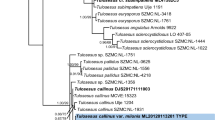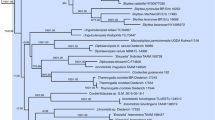Abstract
Five species of Crepidotus (Agaricales, Crepidotaceae) were documented during our ongoing efforts to characterize the fungi of Kerala State, India. Of these, three species are new to science, while C. roseus and C. alabamensis represent new Asian and Indian records, respectively. Herein, we fully describe and illustrate Crepidotus exiguus, C. flavobrunneus, and C. tortus and provide updated descriptions and distributional data for C. alabamensis and C. roseus. A phylogenetic reconstruction based on maximum likelihood analyses of nuclear ribosomal large subunit rDNA sequences is also included.









Similar content being viewed by others
Data availability
All voucher collections are deposited in registered herbaria. All relevant molecular data has been deposited in GenBank and TreeBase. (This has been already indicated in the main text.)
References
Aime MC, Baroni TJ, Miller OK (2002) Crepidotus thermophilus comb. nov., a reassessment of Melanomphalia thermophila, a rarely collected tropical agaric. Mycologia 94(6):1059–1065. https://doi.org/10.2307/3761871
Aime MC, Vilgalys R, Miller OK (2005) The Crepidotaceae (Basidiomycota, Agaricales): phylogeny and taxonomy of the genera and revision of the family based on molecular evidence. Am J Bot 92:74–82. https://doi.org/10.3732/ajb.92.1.74
Aime MC (1999) Generic concepts in the Crepidotaceae as inferred from nuclear large subunit, ribosomal DNA sequences, morphology, and basidiospores dormancy patterns. MSc thesis, Virginia Polytechnic Institute and State University, Blacksburg, USA
Aime MC (2004) Intercompatibility tests and phylogenetic analysis in the Crepidotus sphaerula group complex: concordance between ICGs and nuclear rDNA sequences highlight phenotypic plasticity within two Appalachian species. In ‘Fungi in Forest Ecosystems: Diversity, Systematics and Ecology. (eds CL Cripps) New York Botanical Garden: New York, USA
Bandala VM, Montoya L, Mata M (2008) Crepidotus crocophyllus found in Costa Rica and Mexico and revision of related species in subsection Fulvofibrillosi. Mycologia 100(2):335–346. https://doi.org/10.1080/15572536.2008.11832489
Consiglio G, Setti L (2008) II Genere Crepidotus in Europa. A.M.B. Fondazione Centro Studi Micologici, Vincenza
Crous PW et al (2019) Fungal Planet description sheets: 868–950. Persoonia 42:291–473. https://doi.org/10.3767/persoonia.2019.42.11
Fries EM (1821) Systema mycologicum 1. Lundin, Sweden
Garnica S, Weiss M, Walther G, Oberwinkler F (2007) Reconstructing the evolution of agarics from nuclear gene sequences and basidiospore ultrastructure. Mycol Res 111:1019–1029. https://doi.org/10.1016/j.mycres.2007.03.019
Ge Y, Bau T (2020) Descriptions of six new species of Crepidotus from China. Mycostema, 39(2): 238–255. https://doi.org/10.13346/j.mycosystema.190345
Ge Y, Yang S, Bau T (2017) Crepidotus lutescens sp. nov. (Inocybaceae, Agaricales), an ochraceous salmon colored species from northeast of China. Phytotaxa 297:189–196. https://doi.org/10.11646/phytotaxa.297.2.6
Guzmán-Dávalos L, Pradeep CK, Vrinda KB, Kumar AM, Ramírez-Cruz V, Herrera M, Villalobos-Arámbula AR, Soytong K, Baroni TJ, Aime MC (2017) A new stipitate species of Crepidotus from India and Thailand, with notes on other tropical species. Mycologia 109:804–814. https://doi.org/10.1080/00275514.2017.1401834
Hall TA (1999) Bio Edit: a user-friendly biological sequence alignment editor and analysis program for Windows 95/98/NT. Nucleic Acids Symp Ser 41:95–98
Hesler LR, Smith AH (1965) North American species of Crepidotus. Hafner Publishing Company, New York, USA
Horak E, Matheny PB, Desjardin DE, Soytong K (2015) The genus Inocybe (Inocybaceae, Agaricales, Basidiomycota) in Thailand and Malaysia. Phytotaxa 230(3):201–38. https://doi.org/10.11646/phytotaxa.230.3.1
Izumitsu K, Hatoh K, Sumita T, Kitade Y, Morita A, Gafur A, Ohta A, Kawai M, Yamanaka T, Neda H, Ota Y, Tanaka C (2012) Rapid and simple preparation of mushroom DNA directly from colonies and fruiting bodies for PCR. Mycoscience 53:396–401. https://doi.org/10.1007/s10267-012-0182-3
Jančovičová S, Adamčík S, Looney BP, Caboň M, Čaplovičova M, Kopáni M, Pennycook SR, Adamčíková K (2017) Delimitation of European Crepidotus stenocystis as different from the North American species C. brunnescens (Crepidotaceae, Agaricales). Phytotaxa 328(2):127–139. https://doi.org/10.11646/phytotaxa. 328.2.3
Jeewon R, Hyde KD (2016) Establishing species boundaries and new taxa among fungi: recommendations to resolve taxonomic ambiguities. Mycosphere 7:1669–1677. https://doi.org/10.5943/mycosphere/7/11/4
Kirk PM, Cannon PF, Minter DW, Stalpers JA (2008) Ainsworth & Bisby’s dictionary of the fungi, 10th edn. CAB International, Wallingford
Kornerup A, Wanscher JH (1978) Methuen handbook of color. Methuen, London
Krisai-Greilhuber I, Senn-Irlet B, Voglmayr H (2002) Notes on Crepidotus from Mexico and the Southern-Eastern USA. Persoonia 17(4):515–539
Kumar S, Stecher G, Tamura K (2016) MEGA7: molecular evolutionary genetics analysis version 7.0 for bigger datasets. Mol Biol Evol 33:1870–1874. https://doi.org/10.1093/molbev/msw054
Kumar AM, Vrinda KB, Pradeep CK (2018a) New and noteworthy crepidotoid agarics from India. Cryptogam, Mycol 39:287–298. https://doi.org/10.7872/crym/v39.iss3.2018.287
Kumar AM, Aime MC, Vrinda KB, Pradeep CK (2020) Two new species and a new record of Crepidotus (Agaricomycetes) from India. Aust Syst Bot 33:380–391. https://doi.org/10.1071/SB19033
Kumar AM, Vrinda KB, Pradeep CK (2018b) Two new species of Crepidotus (Basidiomycota, Agaricales) from peninsular India. Phytotaxa 372:67–78. https://doi.org/10.11646/phytotaxa.372.1.5
Larsson E, Vauras J, Cripps C (2014) Inocybe leiocephala, a species with an intercontinental distribution range: disentangling the I. leiocephala subbrunnea–catalaunica morphological species complex. Karstenia 54: 15–39. https://doi.org/10.29203/ka.2014.461
Matheny PB (2005) Improving phylogenetic inference of mushrooms with RPB1 and RPB2 nucleotide sequences (Inocybe; Agaricales). Mol Phylogenet Evol 35:1–20. https://doi.org/10.1016/j.ympev.2004.11.014
Matheny PB, Bougher NL (2006) The new genus Auritella from Africa and Australia (Inocybaceae, Agaricales): molecular systematics, taxonomy and historical biogeography. Mycol Prog 5:2–17. https://doi.org/10.1007/s11557-005-0001-8
Matheny PB, Vellinga EC, Bougher NL, Ceska O, Moreau PA, Neves MA, Ammirati JF (2007) Taxonomy of displaced species of Tubaria. Mycologia 99:569–585. https://doi.org/10.1080/15572536.2007.11832551
Matheny PB, Moreau PA, Vizzini A, Harrower E, De Haan A, Contu M, Curti M (2015) Crassisporium and Romagnesiella: two new genera of dark-spored Agaricales. Syst Biodivers 13(1):28–41. https://doi.org/10.1080/14772000.2014.967823
Moncalvo JM, Vilgalys R, Redhead SA, Johnson JE, James TY, Aime MC, Hofstetter V, Verduin SJ, Larsson E, Baroni TJ, Greg Thorn R, Jacobsson S, Clemen¸con H, Miller OK Jr, (2002) One hundred and seventeen clades of euagarics. Mol Phylogenet Evol 23:357–400. https://doi.org/10.1016/S1055-7903(02)00027-1
Murrill WA (1917) Crepidotus (Fries) Quél. North American Flora 10(3):145–226
Nordstein S (1990) The genus Crepidotus (Basidiomycotina, Agaricales) in Norway. Synopsis Fungorum 2, Norway
Pegler DN (1977) A preliminary agaric flora of East Africa. Kew Bull Addit Ser 6:1–615
Pegler DN (1986) Agaric flora of Sri Lanka. Kew Bull Addit Ser 12:1–519
Pilát A (1950) Revision of the types of some extra-European species of the genus Crepidotus Fr. Trans Br Mycol Soc 33(3–4):215–249
Senn-Irlet B, De Meijer AAR (1998) The genus Crepidotus from the state of Paraná, Brazil. Mycotaxon 66:165–199
Senn-Irlet B (1995) The genus Crepidotus (Fr.) Staude in Europe. Persoonia 16(1):1–80
Singer R (1973) The genera Marasmiellus, Crepidotus and Simocybe in the Neotropics. Beihefte Nova Hedwigia 44:1–517
Singer R (1986) The Agaricales in modern taxonomy, 4th edn. Koeltz Scientific Books, Koenigstein
Singer R, Digilio APL (1951) Pródromo De La Flora Argentina Lilloa 25:5–461
Staude F (1857) Die Schwämme Mitteldeutschlands insbesondere des Herzogthums. Druck der Dietz‘schen Hofbuchdruckerei, Coburg
Trifinopoulos J, Nguyen LT, Haeseler A, Minh BQ (2016) W-IQ-TREE: a fast online phylogenetic tool for maximum likelihood analysis. Nucleic Acids Res 44:W232–W235. https://doi.org/10.1093/nar/gkw256
Varga T et al (2019) Megaphylogeny resolves global patterns of mushroom diversification. Nature Ecology & Evolution 3:668–678. https://doi.org/10.1038/s41559-019-0834-1
Vilgalys R, Hester M (1990) Rapid genetic identification and mapping of enzymatically amplified ribosomal DNA from several Cryptococcus species. J Bacteriol 172:4238–4246. https://doi.org/10.1128/jb.172.8.4238-4246.1990
Vizzini A, Angelini C, Ercole E (2012) A new Neopaxillus species (Agaricomycetes) from the Dominican Republic and the status of Neopaxillus within the Agaricales. Mycotaxon 104(1):138–147. https://doi.org/10.3852/10-345
Watling R, Gregory NM (1989) British fungus flora, vol. 6. Crepidotaceae, Pleurotaceae and other pleurotoid agarics. Royal Botanic Garden Edinburgh.
White TJ, Bruns T, Lee S, Taylor J (1990) Amplification and direct sequencing of fungal ribosomal RNA genes for phylogenetics. In: Innis, M.A., Gelfand, D.H., Sninsky, J.J. & White,T. J. (Eds.) PCR protocols: a guide to methods and applications, Academic Press, San diego, California. https://doi.org/10.1016/b978-0-12-372180-8.50042-1
Acknowledgements
The authors are thankful to the Director, JNTBGRI for the support and facilities and to the two anonymous reviewers for their useful comments and suggestions.
Funding
This work was supported by the Kerala State Council for Science, Technology and Environment Plan program 2019–2020.
Author information
Authors and Affiliations
Contributions
All authors (AMK, CKP, MCA) contributed to the study conception and design. AMK and CKP conducted field work in the state of Kerala, India. AMK and CKP conducted the microscopical and molecular study of the collections. AMK generated the molecular data and conducted the phylogenetic analysis. CKP wrote the first draft of the manuscript, and all authors commented on previous versions of the manuscript. MCA reviewed all aspects of the manuscript before submission. All authors read and approved the final manuscript.
Corresponding author
Ethics declarations
Ethics approval
Not applicable.
Consent to participate
Not applicable.
Consent for publication
Not applicable.
Conflict of interest
The authors declare no competing interests.
Additional information
Section editor: Zhu-Liang Yang.
Publisher's Note
Springer Nature remains neutral with regard to jurisdictional claims in published maps and institutional affiliations.
Rights and permissions
About this article
Cite this article
Kumar, A.M., Pradeep, C.K. & Aime, M.C. New species and new records of Crepidotus (Crepidotaceae) from India. Mycol Progress 21, 311–326 (2022). https://doi.org/10.1007/s11557-021-01751-3
Received:
Revised:
Accepted:
Published:
Issue Date:
DOI: https://doi.org/10.1007/s11557-021-01751-3




